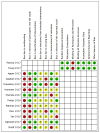Direct oral anticoagulant (DOAC) versus low-molecular-weight heparin (LMWH) for treatment of cancer associated thrombosis (CAT): A systematic review and meta-analysis
- PMID: 29506866
- PMCID: PMC6119655
- DOI: 10.1016/j.thromres.2018.02.144
Direct oral anticoagulant (DOAC) versus low-molecular-weight heparin (LMWH) for treatment of cancer associated thrombosis (CAT): A systematic review and meta-analysis
Abstract
Introduction: It is unclear if direct oral anticoagulants (DOACs) are effective and safe alternatives to low-molecular-weight heparin (LMWHs) for the treatment of cancer-associated venous thromboembolism (VTE). We aim to synthesize existing literature that compared DOACs versus LMWHs in this high-risk population.
Materials and methods: We conducted a systematic review using EMBASE, MEDLINE and CENTRAL for all observational studies and randomized controlled trials (RCTs) (PROSPERO: CRD42017080898). Two authors independently reviewed study eligibility, extracted data, and assessed bias. Primary outcomes included 6-month recurrent VTE and major bleeding. Secondary outcomes included clinically relevant non-major bleeding (CRNMB) and mortality.
Results: We screened 426 articles, reviewed 25 in full-text, and selected 13 and 2 for qualitative and quantitative synthesis, respectively. Based on a meta-analysis of the 2 RCTs, DOACs had lower 6-month recurrent VTE (42/725) when compared to LMWH (64/727) (RR: 0.65 (0.42-1.01)). However, DOACs had higher major bleeding (40/725) when compared to LMWH (23/727) (RR 1.74 (1.05-2.88)). Similarly, CRNMB was higher (RR 2.31 (0.85-6.28)) for patients receiving DOACs. There was no difference in mortality (RR 1.03 (0.85-1.26)). Observational studies were heterogeneous with high risks of bias but showed recurrent VTE rates consistent with the meta-analysis.
Conclusions: DOACs were more effective than LMWHs to prevent recurrent VTE but were associated with a significantly increased risk of major bleeding as well as a trend toward more CRNMB. The absolute risk differences were small (2-3%) for both primary outcomes and may reflect better compliance with DOACs than LMWHs.
Keywords: Factor Xa inhibitors; Heparin; Low-molecular-weight; Neoplasms; Venous thrombosis.
Copyright © 2018 The Authors. Published by Elsevier Ltd.. All rights reserved.
Conflict of interest statement
Figures



Comment in
-
Low-molecular weight heparin or direct oral anticoagulants for the treatment of cancer associated thrombosis. Are we at the crossroad?Thromb Res. 2019 Jan;173:156-157. doi: 10.1016/j.thromres.2018.11.028. Epub 2018 Nov 29. Thromb Res. 2019. PMID: 30528079 No abstract available.
References
-
- Prandoni P, Lensing AWa, Piccioli A, Bernardi E, Simioni P, Girolami B, Marchiori A, Sabbion P, Prins MH, Noventa F, Girolami A. Recurrent venous thromboembolism and bleeding complications during anticoagulant treatment in patients with cancer and venous thrombosis. Cancer. 2002;100:3484–3488. doi: 10.1182/blood-2002-01-0108.Reprints. - DOI - PubMed
-
- Prandoni P, Lensing AWA, Piccioli A, Bernardi E, Simioni P, Girolami B, Marchiori A, Sabbion P, Prins MH, Noventa F, Girolami A. Recurrent venous thromboembolism and bleeding complications during anticoagulant treatment in patients with cancer and venous thrombosis. Blood. 2002;100:3484–3488. doi: 10.1182/blood-2002-01-0108. - DOI - PubMed
-
- Lee AYY, Levine MN, Baker RI, Bowden C, Kakkar AK, Prins M, Rickles FR, Julian JA, Haley S, Kovacs MJ, Gent M Randomized Comparison of Low-Molecular-Weight Heparin versus Oral Anticoagulant Therapy for the Prevention of Recurrent Venous Thromboembolism in Patients with Cancer (CLOT) Investigators. Low-molecular-weight heparin versus a coumarin for the prevention of recurrent venous thromboembolism in patients with cancer. N Engl J Med. 2003;349:146–53. doi: 10.1056/NEJMoa025313. - DOI - PubMed
Publication types
MeSH terms
Substances
Grants and funding
LinkOut - more resources
Full Text Sources
Other Literature Sources
Medical
Miscellaneous

